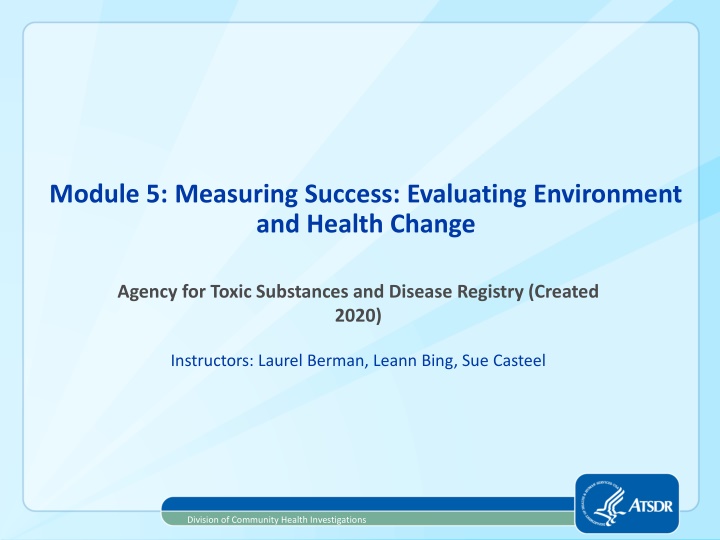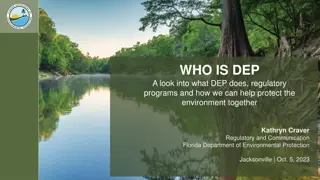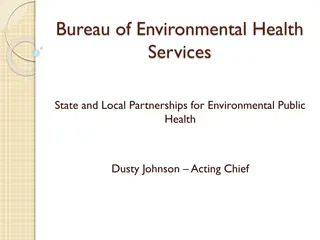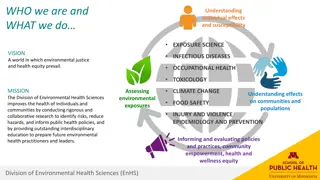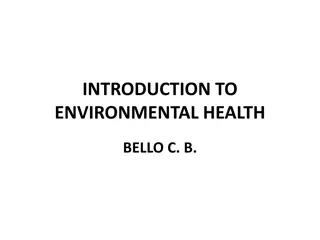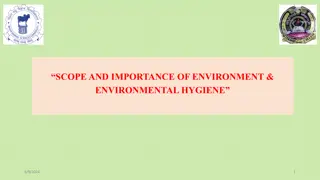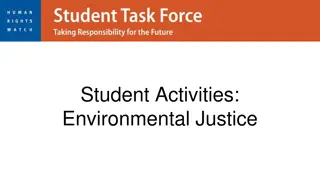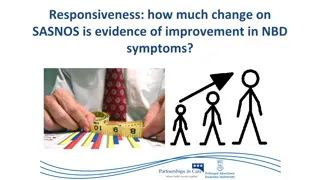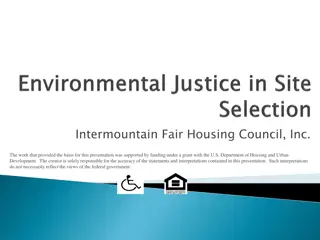Measuring Success in Environmental and Health Change Agency
Evaluating community-driven public health indicators associated with land reuse and redevelopment is crucial for measuring success in environmental and health change agency. This module focuses on the role of environmental and health professionals in tracking changes in areas such as environment, health, and economy to ensure the well-being of communities. Participants learn about key indicators, the importance of measuring change, and practical skills for development community team members.
Download Presentation

Please find below an Image/Link to download the presentation.
The content on the website is provided AS IS for your information and personal use only. It may not be sold, licensed, or shared on other websites without obtaining consent from the author.If you encounter any issues during the download, it is possible that the publisher has removed the file from their server.
You are allowed to download the files provided on this website for personal or commercial use, subject to the condition that they are used lawfully. All files are the property of their respective owners.
The content on the website is provided AS IS for your information and personal use only. It may not be sold, licensed, or shared on other websites without obtaining consent from the author.
E N D
Presentation Transcript
Module 5: Measuring Success: Evaluating Environment and Health Change Agency for Toxic Substances and Disease Registry (Created 2020) Instructors: Laurel Berman, Leann Bing, Sue Casteel Division of Community Health Investigations
Course Objectives After finishing this module, you should be able to Describe three general public health categories for which there are community-driven public health indicators associated with land reuse and redevelopment. Describe at least three public health indicators that are associated with land reuse and redevelopment in each of three public health categories: Environment, Health, Economy Access the Action Model to include community-driven public health indicators in redevelopment plans. Explain the role, responsibilities, and scope of practice of a development community team member.
Course Details Pre-test Post-test: 70% or higher to receive a certificate Create a 4-digit number to put on your pre- and post- tests Memorize the number or keep a written copy Use the same number on both the pre- and post- test An environmental professional frustrated over taking a pre- test. ATSDR, 2019.
Pre-test Pre-test Module 5 Put your 4-digit number on the top right corner of your pre- test
Measuring Change Environmental or health professionals can measure changes that occur throughout land reuse/redevelopment 3 typical measurement categories Environment Health Economy
Why Measure Change? Track changes in the physical and mental health (well being) of the community Track changes in the environmental health of the community
Knowledge Check #1 Select the best answer: The environmental or health professional can measure community changes in which three typical categories: a) Economy b) Health c) Gentrification d) Property availability e) Environment f) Community acceptance
Environmental, Health, and Economic Indicators Definable Are measurable Have a data source Example Lead issues Indicator is blood lead levels in children Is it definable? What? Is it measurable? How? What is the data source?
Example Indicators Issue Indicator River pollution Water quality data Fish consumption advisories Lack of parks and/or green space Number and types of vacant lots Number and use of green parcels Number of parks Number of bike lanes/trails Vacant and contaminated properties Inventory of sites Inventory of contaminants and associated health effects Map of sites Habitat concerns Wildfire survey Environmentally friendly lighting Habitat preservation
Knowledge Check #2 Select the best answers: What indicators currently collected by communities can environmental or health professionals draw on to measure changes in environment ? a) Creation of a site inventory that incorporates a public health focus b) Pre- and post-redevelopment blood lead level data c) The number, size, and uses of green space d) The number of structures demolished and the number redeveloped
Knowledge Check #3 Select the best answers: What indicators currently collected by communities can environmental or health professionals draw on to measure changes in health (physical and mental health/well being)? a) Pre- and post-redevelopment blood lead level data b) The number, size, and uses of green space or recreational areas c) Crime statistics d) The number of structures demolished and the number redeveloped
Knowledge Check #4 Select the best answers: What indicators can an environmental or health professional draw on that are currently collected by communities to measure changes in economy? a) The number, size, and uses of green space or recreational areas b) Crime statistics c) Property value of housing d) Demographic data on income, poverty, employment, and occupation e) Pre- and post-redevelopment blood lead level data
Identifying Health Outcomes The success of a project may depend on tracking and evaluating the community s overall health: Physical health Mental health/community involvement Environmental improvement Built environment Economy Education Safety/Security Environmental resources Housing
Example of Identifying Health Outcomes Community wants more access to healthy foods Issue: We need more community gardens and grocery stores Outcome: Increased access to healthy foods (with associated indicators to track, such as # of full service grocery stores, # of community gardens)
Outcomes: A Change or a Result Lowered blood lead levels in children Increased property values New hospital with 10 new primary care providers New grocery store with a full range of healthy food 10 sites demolished or redeveloped, lowering risk of exposure to lead, asbestos, volatile compounds, and petroleum A new business opened and 20 jobs created for youth
Action Model Toolkit Four steps of health-focused redevelopment Step 4 creates community- driven public health indicators that can be tracked to measure changes in health outcomes ATSDR has consolidated the indicators from 40 action models Refer to hand-outs at your table
ATSDR Community Health and Land Reuse Scorecard You can fill in the Land ReuseAction Model Step 4 withindicators consolidated from 40 communities Scorecard Collect or create indicators Paste into Action Model Step 4
Community Health and Land Reuse Indicators Classroom exercise Small groups Review and use Land Reuse Action Model Template Use indicator scorecard and indicator summaries
Knowledge Check #5 Environmental or health professionals can use the Land Reuse Action Model Toolkit and indicator materials to help their communities select environment, health, economic, and other categories and indicators to incorporate in redevelopment plans. a) True b) False
Case Study: Asbestos Mine The ABC site in Keweenaw Peninsula (mock) Active asbestos mine from early 1900s to 1993 Chrysotile mined Tons of waste rock and mine tailings Contaminated runoff from the mine tailings Surface water, stream, and sediment contamination Downstream wetland areas contaminated Source of airborne asbestos Recreational area for activities such as hiking on tailings piles.
Case Study: Recommendations and Messages for Regulatory and Health Agencies Restrict access to the ABC Mine property Prohibit and discourage recreational use of site to minimize exposure Prevent the removal and reuse of tailings and all other material beyond the ABC property Don t use wetlands located downstream for camping or other recreational activities.
Case Study: Asbestos Mine - Outcomes Education and awareness campaign developed Federal, state, environmental and health agencies Campaign informed residents about asbestos exposures and encouraged residents to minimize exposure by staying off the mine property Site identified as a hazardous place where recreation can be dangerous to people s health Asbestos exposure prevented for160 people per year
Knowledge Check #6 Select all of the messaging actions that apply a) Communicated findings and concerns to state and federal agency partners b) With partners, encouraged residents to minimize exposure to asbestos by staying off the mine property c) Allowed people to continue skiing or hiking on the sites as long as the snow was at least 3 inches deep d) Prevented 160 people per year from being exposed to asbestos e) Went hiking on the site with visitors to demonstrate that there was no risk of recreating on the site
Issues vs. Indicators vs. Outcomes Issues are community concerns related to redevelopment E.g., contamination, contaminated site location, exposure concerns Indicators can be derived to track progress towards achieving an improvement in health (the outcome) related to the issue E.g., list and location of contaminated sites, blood screening results Outcomes are changes in health, environment, economy and many other public health categories E.g., increased access to healthy foods, lowered obesity rates, reduction in chemical exposures, increased property values
Tabletop Exercise: Issues, Indicators, and Outcomes Play the Name that Issue/Indicator/Outcome game Stay in your groups On each table, there are decks of cards Sort the cards into three piles: issues, indicators, or outcomes Work together!
Post-test Place your 4-digit number on the top of your test You can retake the test multiple times Test is open book Passing score of 70% is required Bring your test in tomorrow for grading
Thank you! Laurel Berman, laberman@cdc.gov Leann Bing, kbing@cdc.gov Sue Casteel, scasteel@cdc.gov Division of Community Health Investigations
